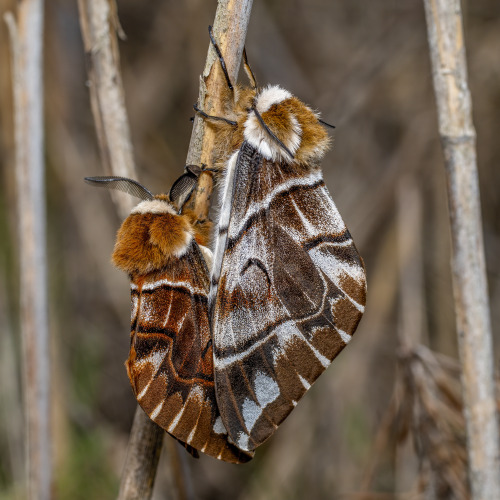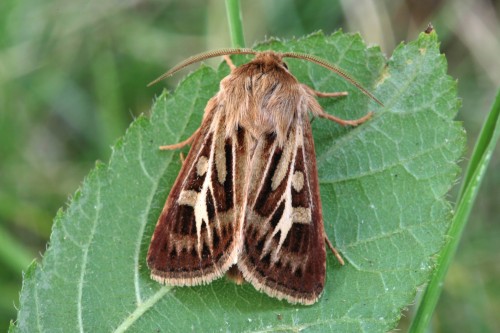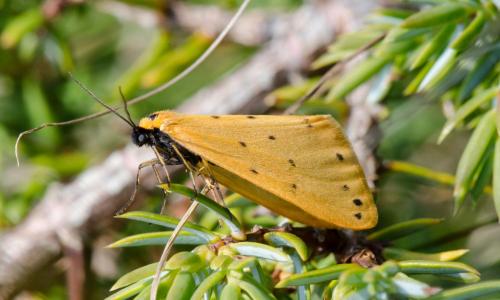
Live, Laugh, Lamp | Moth Requests OPEN |Unreliable Posting Schedule (usually on Sundays)
60 posts
Moth Of The Week
Moth of the Week
Kentish Glory
Endromis versicolora

The Kentish glory was first described in 1758 by Carl Linnaeus. It is a part of the family Endromidae which was created in 1810 by Ferdinand Ochsenheimer. This is a monotypic genus, meaning there is only one species in it being the Kentish glory.
Description The male and female of this species are clearly told apart by their colors and size.
Males are darker and more orange than females with feathery antennae
Males hindwings are orange
Females are paler/more washed out in color and larger to carry eggs
The forewings of this moth are a marbled black, orange, and white. The outer edge of the wing called the outer margin is brown with white stripes along the veins. The females hindwings are the same marbled black, brown, and white with a brown edge. The males hindwings are orange with brown markings.
The legs and antennae are black while the thorax is brown and white. The females abdomen is black while the males abdomen is a similar orange to the hindwing.
Sources differ on wingspan range.
Wikipedia: 50 - 70 mm (≈1.97 - 2.76 in)
Butterfly Conservation: Male 27 - 30 mm (≈1.06 - 1.18 in), Female 34 - 39 mm (≈1.34 - 1.54 in)
Diet and Habitat The larvae of this species eats mainly birch (Betula species) but will eat other trees and shrubs such as Alnus, Corylus, Tilia and Carpinus species. Adults do not feed.
This moth’s range used to be much larger, such as living in the southern and western English counties of Kent, Sussex, Berkshire, East Anglia, Herefordshire, and Worcestershire and the southeastern Welsh county of Monmouthsire.
Now this moth is restricted to living in the central and eastern Highlands of Scotland. It is seen in the Scottish counties of Perthshire, Inverness-shire, Morayshire, Aberdeenshire and Kincardineshire.
They prefer to inhabit open birch woodland and lightly wooded moorland.
Mating Females use pheromones to attract males, who can detect them from 1-2 km (≈0.62 - 1.24 mi) away.
This species has one single generation per year. The females lay their eggs, which are yellow at first then purplish-brown, in batches of 10-20 eggs on low birch scrub at an average height of 1.2m (≈1.31 yd). They prefer to let them on sheltered, unshaded saplings, usually the first few batches are near where the females emerged. The eggs hatch after 10 to 14 days.
Predators Males usually fly during the day from mid morning to early afternoon while females fly at dusk. Because of this males are presumably preyed on by daytime birds while females are preyed on by bats.
Fun Fact The females do not fly as strong as males due to the eggs they carry as it weighs them down. Females tend to lay their first few batches of eggs close to where they emerged due to this fact.
(Source: Butterfly Conservation, Wikipedia, Rothiemurchus)
-
 nando161mando liked this · 9 months ago
nando161mando liked this · 9 months ago -
 dixieandherbabies liked this · 1 year ago
dixieandherbabies liked this · 1 year ago -
 rhino-beetles reblogged this · 1 year ago
rhino-beetles reblogged this · 1 year ago -
 girlsaredopamine liked this · 1 year ago
girlsaredopamine liked this · 1 year ago -
 terominidan liked this · 1 year ago
terominidan liked this · 1 year ago -
 shiny-murkrows reblogged this · 1 year ago
shiny-murkrows reblogged this · 1 year ago -
 pangofizz reblogged this · 1 year ago
pangofizz reblogged this · 1 year ago -
 pangofizz liked this · 1 year ago
pangofizz liked this · 1 year ago -
 0ranges0daa liked this · 1 year ago
0ranges0daa liked this · 1 year ago -
 mothghost69 reblogged this · 1 year ago
mothghost69 reblogged this · 1 year ago -
 mothghost69 liked this · 1 year ago
mothghost69 liked this · 1 year ago -
 lovesbooksdoesntread liked this · 1 year ago
lovesbooksdoesntread liked this · 1 year ago -
 technolily liked this · 1 year ago
technolily liked this · 1 year ago -
 chompymantis liked this · 1 year ago
chompymantis liked this · 1 year ago -
 solgavee liked this · 1 year ago
solgavee liked this · 1 year ago -
 addamsjuice reblogged this · 1 year ago
addamsjuice reblogged this · 1 year ago -
 addamsjuice liked this · 1 year ago
addamsjuice liked this · 1 year ago -
 ittybittykittyfingers liked this · 1 year ago
ittybittykittyfingers liked this · 1 year ago -
 significantlylesschill liked this · 1 year ago
significantlylesschill liked this · 1 year ago -
 daughterofdurin liked this · 1 year ago
daughterofdurin liked this · 1 year ago -
 dreamkingoneiros liked this · 1 year ago
dreamkingoneiros liked this · 1 year ago -
 i-skenda liked this · 1 year ago
i-skenda liked this · 1 year ago -
 well-of-a-vermin liked this · 1 year ago
well-of-a-vermin liked this · 1 year ago -
 silverchauffeur liked this · 1 year ago
silverchauffeur liked this · 1 year ago -
 torisanpo28 liked this · 1 year ago
torisanpo28 liked this · 1 year ago -
 saturnmortis liked this · 1 year ago
saturnmortis liked this · 1 year ago -
 bulbasauryeee liked this · 1 year ago
bulbasauryeee liked this · 1 year ago -
 demoncappuccino liked this · 1 year ago
demoncappuccino liked this · 1 year ago -
 johannsb liked this · 1 year ago
johannsb liked this · 1 year ago -
 commander-pigeon liked this · 1 year ago
commander-pigeon liked this · 1 year ago -
 mrbonsaibones liked this · 1 year ago
mrbonsaibones liked this · 1 year ago -
 cafekat reblogged this · 1 year ago
cafekat reblogged this · 1 year ago -
 goatxsheep liked this · 1 year ago
goatxsheep liked this · 1 year ago -
 lowlytickbather reblogged this · 1 year ago
lowlytickbather reblogged this · 1 year ago -
 lichen-the-goblin liked this · 1 year ago
lichen-the-goblin liked this · 1 year ago -
 beaujagr liked this · 1 year ago
beaujagr liked this · 1 year ago -
 cin-the-moth reblogged this · 1 year ago
cin-the-moth reblogged this · 1 year ago -
 bastardzone liked this · 1 year ago
bastardzone liked this · 1 year ago -
 kaizokushojo liked this · 1 year ago
kaizokushojo liked this · 1 year ago -
 lonelyspaceman reblogged this · 1 year ago
lonelyspaceman reblogged this · 1 year ago -
 heyomaple reblogged this · 1 year ago
heyomaple reblogged this · 1 year ago -
 harnator liked this · 1 year ago
harnator liked this · 1 year ago -
 sunnyspiders liked this · 1 year ago
sunnyspiders liked this · 1 year ago -
 andreiacsantos liked this · 1 year ago
andreiacsantos liked this · 1 year ago -
 spycrab9000 liked this · 1 year ago
spycrab9000 liked this · 1 year ago -
 yrlocalghost liked this · 1 year ago
yrlocalghost liked this · 1 year ago
More Posts from Libraryofmoths
Moth of the Week
Drinker
Euthrix potatoria

The drinker moth is of the family Lasiocampidae. It was described and named in 1758 by Carl Linneaus. Linneaus chose the species name potatoria as it means ‘drinker-like.’ Dutch entomologist Johannes Goedaert had previously called the moth dronckaerdt, meaning ‘drunkard,’ “because it is very much inclined to drinking” or because this moth repeatedly puts its head into water. The common name ‘drinker’ comes from the same reason.
Description This moth is distinguishable from other eggar moths by a diagonal line crossing the forewing and two white spots also on the forewing. Males are usually reddish or orangish-brown with yellow patches. Males in East Anglia are often yellowish. Females can be yellow, a pale buff, whitish, or a darker reddish-brown than the males. Male and females also differ in size and antennae shape: females are slight larger than males, and males have fluffier antennae.
Wingspan Range of Fully Grown Drinker: 45–65 mm (≈1.77 - 2.56 in)
Diet and Habitat The caterpillars of this species feed on grasses and reeds in genuses such as Alopecurus, Deschampsia, Dactylis, Elytrigia, Carex, Luzula, and other Gramineae. A few examples are Cat grass (Dactylis glomeratus), Common Reed (Phragmites australis), Reed Canary-grass (Phalaris arundinacea), and Wood Small-reed (Calamagrostis epigejos).
In the spring, they feed mainly at night and can be found resting on low vegetation during the day. The larva also supposedly drink morning dew because it had been observed to repeatedly put its head in water.
This moth can be found in Europe. It is common throughout England and Ireland but tends to favor western Scotland over eastern Scotland. It prefers habitats of marshy places such as fens, riversides, tall and damp grassland, marshes, damp open woodland, scrub, and ditches. However this species does sometimes live in drier habitats such as grassy terrain and urban gardens.
Mating Adults can been seen between July and August and presumably mate during this time. There is only one generation per year. Eggs are laid mainly on the stems of grasses or reeds in small clusters.
Predators Adult moths fly at night and are presumably preyed on by nocturnal predators such as bats.
Fun Fact Both sexes of the drinker moth are attracted to light, but males are especially susceptible.
(Source: Wikipedia, Butterfly Conservation)
Moth of the Week
Antler Moth
Cerapteryx graminis

The antler moth is a part of the family Noctuidae. It was first described in 1758 by Carl Linnaeus. This moth gets its name from the antler shaped mark in its forewings.
Description This moth species has brown forewings, with a “basal streak” of white that branches out. This mark may vary in size per moth. The forewings show a mirrored pattern of the base brown broken up by the branches and a few spots and lines of lighter brown. The forewing also may or may not have black streaks. The hindwing is dark brown with a white fringe.
Males are smaller than females with fluffier antennae.
Male Wingspan: 27 - 32mm (≈1.06 - 1.26in)
Female Wingspan: 35 - 39mm (≈1.38 - 1.53in)
Diet and Habitat The larva of this species feeds on grasses such as Deschampsia, Sheep’s-fescue (Festuca ovina), Mat-grass (Nardus stricta) and Purple Moor-grass (Molinia caerulea). It has also been found on sedges and rushes. When the larva population is concentrated enough, they can damage pastures. Adults feed on flowers such as thistles and ragworts.
This species is common through most of Europe. It’s northernmost reach is Iceland and above the Arctic Circle. It’s easternmost reach is Siberia and North Mongolia. This moth does not occur in the dry southern regions of Europe. It has been introduced to North America. Additionally, this species inhabits the Alps. They prefer habitats of grassland, favouring acid upland pasture, moorland and downland.
Mating Adult moths are seen flying from July to September. They presumably mate in this time frame.
Predators This moth flies during the day, especially in the north, warm weather, and early mornings, and at night. They are presumably preyed on by both daytime and night time predators like birds and bats. They are attracted to light. To protect themselves during the day, this moth hides in the grass.
Fun Fact The antler moth rises to an altitude of 2100 meters in the Alps.
(Source: Wikipedia, Butterfly Conservation)
rosy maple moth pls
Hello! I have covered this moth before, you can find it here! :]
Moth of the Week
Canary-shouldered Thorn
Ennomos alniaria

The canary-shouldered thorn was first described in 1758 by Carl Linnaeus. It is a part of the family Geometridae. This moth gets its name from its bright yellow coloring.
Description This moth has a bright canary yellow head and thorax. The forewings and hindwings are a ochre yellow with gray speckles. Both the forewings and the hindwings are a scalloped shape and both have a single dot on each wing called “discal spots” with the spots being larger on the hindwing. The forewings have two curved lines going across them.
This moth looks very similar to the Dusky Thorn, August Thorn and September Thorn moths.
Wingspan Range: 34 - 42 mm (≈1.34 - 1.65 in)
Forewing Range: 16 - 20 mm (≈0.63 - 0.79 in)
Diet and Habitat The larva of this species feed off of deciduous trees such as downy birch, silver birch, alder, goat willow, elms, and limes.
This moth’s range stretches from Russia and the Caucuses region in the east to Western Europe in the west and from Fennoscandia in the north to the northern Mediterranean in the south. It has also been introduced into British Columbia. The prefer habitats of woodland, scrub, parks and rural gardens.
Mating This moth has one generation per year. They can be seen flying from July and October and presumably mate during this time.
Predators This species is nocturnal and presumably majorly preyed on my nighttime predators such as bats. However it does use a form a camouflage as larva. The caterpillars of this species resemble dead twigs. This may also help against daytime predators.
Fun Fact The canary-shouldered thorn is attracted to light.
(Source: Wikipedia, Butterfly Conservation, Moths of Britain)
Moth of the Week
Dew Moth
Setina irrorella

Photo credit
The dew moth is a part of the family Erebidae. It was first described in 1758 by Carl Linnaeus. It is thought to have gotten its common name from how the moth hangs from a blade of grass or a leaf when resting during the day. This gives it a transparent look.
Description This species’s wings can vary in colour from cream to yellow. The forewing has 3 lines of black dots across it with the hindwing usually having only one black dot. The underside of the forewing is gray with a yellow margin. The body is black with yellow or black legs.
There are many found variations of this moth:
signata Borkh. - the middle rows of spots are connected by streaks
ab. fumosa Sandb. - has brownish ground colour; found in the north, but also found in Germany.
flavicans Bdv. - has brighter deep yellow wings and the apex of the abdomen is yellow; found in the Mediterranean and Anterior Asia.
nickerli Rebel - paler yellow, the forewing slightly dulled with the exception of the clearer yellow inner margin; found in the Alps and Northern Europe.
andereggi H.-Schiff. - has dark veins on the forewings, appearing like rays; found in the high Alps, and in the higher North.
riffelensis Fall. - considerably smaller, the ground colour is slightly dulled, the black vein-streaks are more numerous, especially the costa and median veins strongly sooty black; found in the high Alps, especially abundant above Zermatt.
lata Christ. - larger with broader wings and paler with very few markings, the hindwing often quite without markings; found in Russia over North Siberia to Kamtschatka.
insignata Stgr., - quite similar to the preceding, but with narrower wings. The forewing also with very few dots, and hindwing without any; found in East Siberia.
Wingspan Range: 27 – 33 mm (≈1.06 - 1.30 in)
Forewing Range: 11 – 18 mm (≈0.43 - 0.71 in)
Diet and Habitat The larva of this moth eat only lichen.
This moth is found in the Palearctic region. Its range starts from Ireland, then spreads south through Europe and east to northern and Central Asia. It can be found in countries such as Siberia, Kamchatka, Chukotka, and northern Mongolia. This species can even live in the limestone Alps up to 2,000 meters above sea level. However, it can not be found in the high north and parts of the Mediterranean region.
It prefers to live in mossy and lichen-covered rock corridors, on chalky and sandy areas and steep, rocky sparse grasslands, rocky coasts, shingle beaches, and calcareous grassland inland. It can also be found in bogs, forest meadows, and on heaths.
Mating Depending on location, this moth can be seen from May to July. It presumably mates during this time. Generations per year not listed.
Predators Not listed. However, the adult males fly in the afternoon, at dusk, after dark, and at dawn. The females are largely nocturnal. These moths are presumably preyed on by nighttime predators such as bats.
Fun Fact The dew moth has four subspecies:
Setina irrorella irrorella
Setina irrorella freyeri (Nickerl, 1845)
Setina irrorella insignata (Staudinger, 1881)
Setina irrorella mediterranea (Daniel, 1964)
Additionally, dew moth caterpillars do not cocoon in trees or foliage but rather in between stones or rocks.
(Source: Wikipedia, Butterfly Conservation)